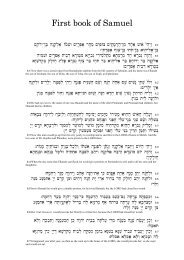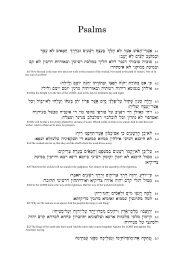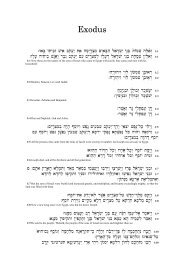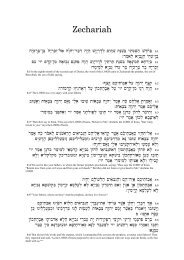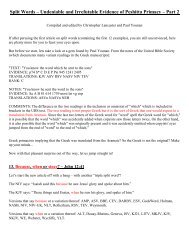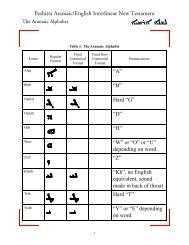ana translation
Untitled - Peshitta Aramaic/English Interlinear New Testament
Untitled - Peshitta Aramaic/English Interlinear New Testament
- No tags were found...
Create successful ePaper yourself
Turn your PDF publications into a flip-book with our unique Google optimized e-Paper software.
INTRODUCTION<br />
Ixxi<br />
POSTSCRIPT. The Pericope de Adultera.<br />
Concerning the Syriac MSS in which the passage, John vii. 53<br />
viii.<br />
12, is to be found, sufficient particulars will be found on p. 3 infr. (see<br />
also pp. 41 49, 87 92).<br />
The facts may be summed up<br />
as follows :<br />
1. Its <strong>translation</strong> into Syriac, in the form in which it appears in<br />
Walton's Polyglot and subsequent Syriac New Testaments (distinguished<br />
as I., p. 41 infr.),<br />
is ascribed in some copies, including the earliest, to<br />
"the Abbot Paul, who found it in Alexandria" (see pp. 41, 42 infr.),<br />
to whom we<br />
presumably the Paul of Telia of the early seventh century,<br />
owe the Syro-Hexaplar Old Testament (see Introduction to Part II,<br />
infr.).*<br />
Of the eight copies of it (p. 3 infr.), cited in the Apparatus<br />
which accompanies the text (Codd. a, 6, c, d, e, f, 10, 16), one only<br />
(16) reads it in the Gospel text (Peshitta), one only (b) as part of<br />
a Lection from the Gospel (Peshitta), one only (e) in the Gospel<br />
text (Harklensian). The rest include it as an extract (as/, 10, 15),<br />
or (as c) append it to, or (as d) set it on the margin of, the Fourth<br />
Gospel (Harkl.), or finally (as a, the oldest) write it on a fly-leaf of an<br />
Another recension of the narrative,<br />
early MS of the Peshitta Gospels. f<br />
infr., p. 45, differing only in wording, is found in Codd. g and 15 ;<br />
former of which includes it in the Peshitta text of the Gospel, the<br />
latter inserts it on a separate leaf attached to a copy of the Catholic<br />
Epistles.<br />
it<br />
the<br />
Of the above, the two (Codd. g and 16), which alone treat<br />
as part of the Peshitta Gospel text, are of the seventeenth century.<br />
2. The story in a form substantially different, of which the Syriac text<br />
is preserved in the eighth Book (ch. vii.) of the Chronicle which bears<br />
the name of Zacharias of Mitylene,J is given (distinguished as II) at<br />
p. 46 infr., from Codd. h and i, of which the former is a copy of the<br />
Chronicle, the latter an extract from the same. In Cod. / also (a copy<br />
of Bar-Salibi's Comm. on the Gospels),<br />
it is cited in extenso after the<br />
comments on Joh. followed vii.,<br />
by the other (Paul-) form of the same.<br />
* Or else his contemporary, the " Abbot Paul," who in A.D. 624, in Cyprus,<br />
translated into Syriac the works of Gregory Nazianzen. See Assemani (B.O., t. i,<br />
p. 171), who calls him Bishop of Cyprus ; Wright, CataL, p. 423 ;<br />
also his Syriac<br />
Lit., p. 135.<br />
'<br />
t For the history of its appearance in print, and of its admission into the<br />
printed Syriac New Testament, see under Cod. 10 (p. Iv supr.).<br />
J Printed by Land, Anecdota Syr., t. in. Dr. Hamilton and Mr. Brooks have<br />
published an English <strong>translation</strong> of the Chronicle (1899), to which the latter has<br />
prefixed an important Introduction.



